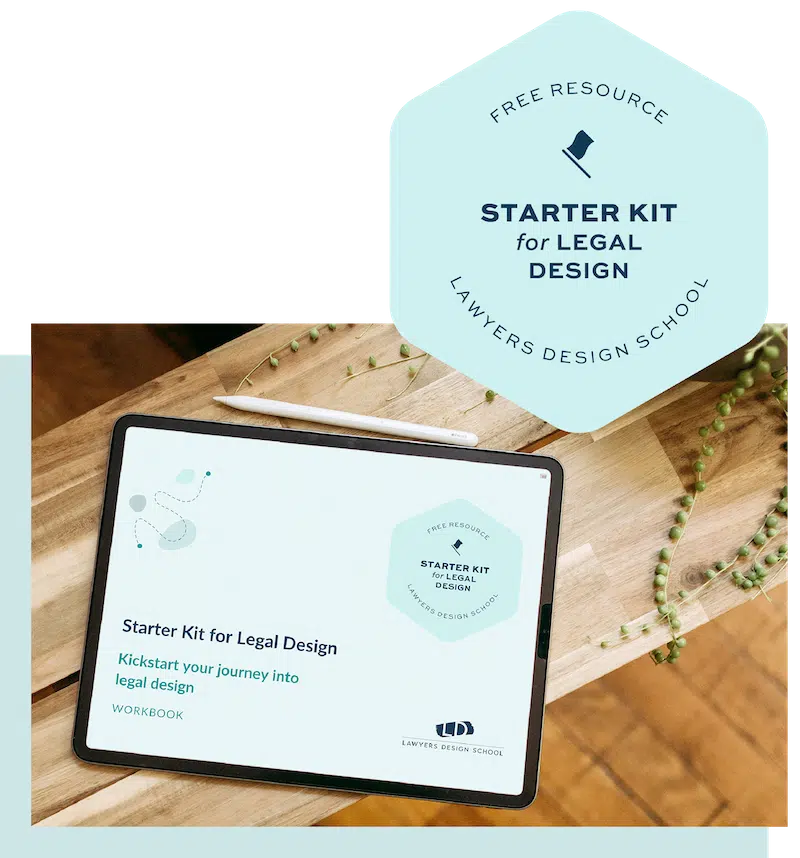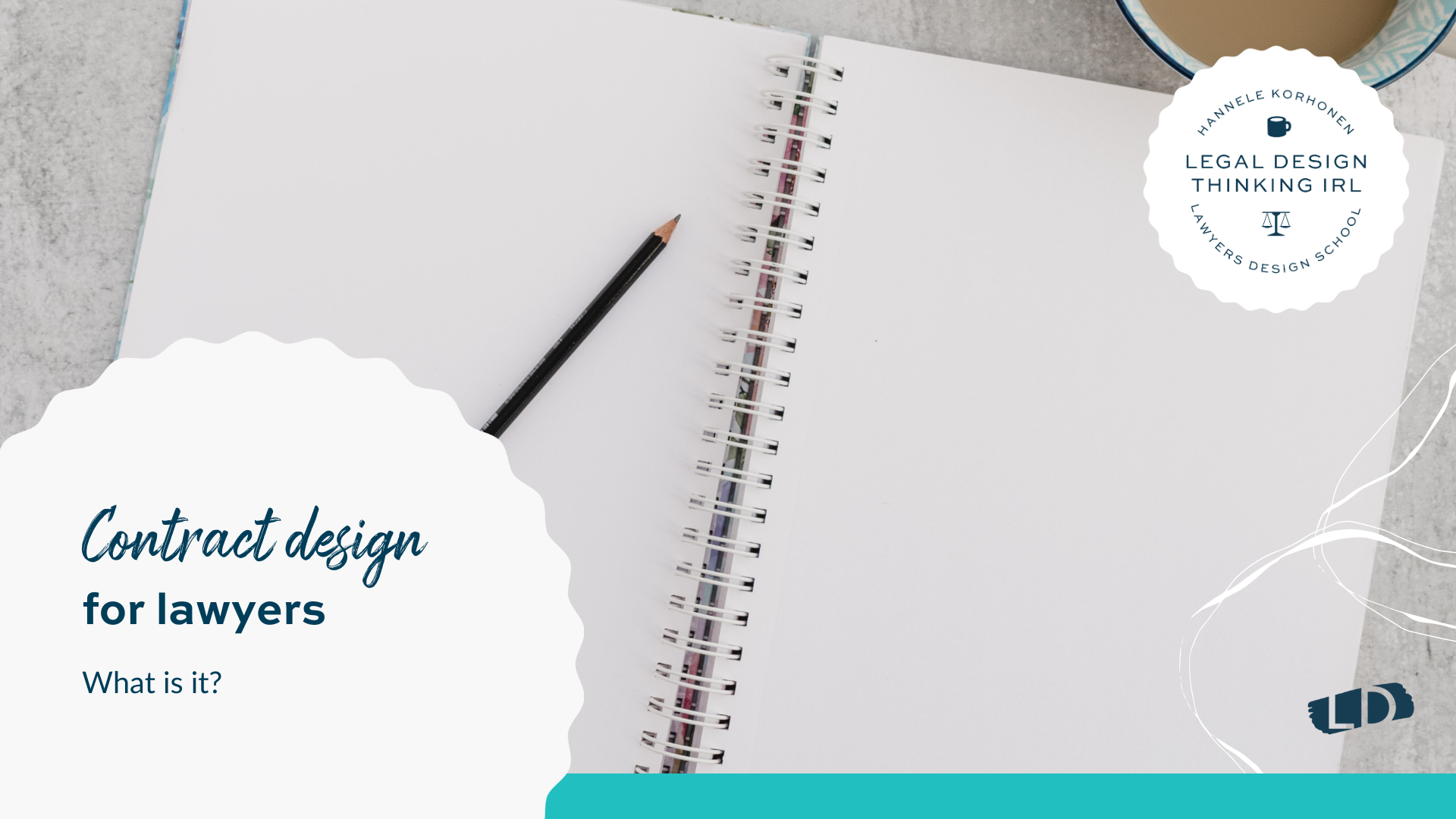What is contract design?
Contract design is a customer-centric approach to contracts that uses legal design as its foundation. Contract design
- make contracts easier for the user to understand
- structures and presents contracts in a new way
- takes complex legal writing and simplifies it with plain language
- uses visual law by applying different visual elements in your contracts
And allows your customer can understand their contract and close deals easier and faster.
And you don’t need to be a designer.
If you want to know more about contract design, check out our Contract Design School where you can learn everything you need to know about contract design: simplification, visualization and serve your clients the way you’ve always wanted to.
Better contracts – what’s in it for you?
You do a lot of legal writing in your day, right? Have you ever wondered if there’s a better way?
Contract design offers lawyers a fresh framework and tools to use every day for contracts, legal documents and legal writing.
And contract design offers lawyers a tangible place to start with legal design.
I wish someone had told me about contract design when I started my career. I spent years working with complex contracts when all I wanted to do was make things easier for my colleagues and my clients.
But it’s here now and I’m ready to teach you everything I know.
Contract design allows you to use your creativity in a new way. I believe contract work is very creative, but contract design takes the creative work to a new level.
By adding visual law or starting to play with the language, new possibilities open everywhere.
You can be the go-to lawyer when your clients want someone to make sense of the complex.
Even if you think you’re not creative – I know you are. It’s the profession that’s stifled the energy and you can use your creativity in your legal work in a way that helps your clients.

STARTER KIT FOR LEGAL DESIGN
Free resource
Get this free resource to kickstart your journey into legal design.
Add empathy, simplicity, and creativity to your legal work and elevate customer experience.
Contract design in real life
When I started Lawyers Design School, I needed terms and conditions for the legal design workshops and courses. No biggie because of decades of experience with contracts, but this time I thought about it.
Traditional contracts
If it had been 10 years ago, I would have grabbed a precedent and cut and pasted the same complex terms and conditions no one ever reads.
The terms and conditions would represent the lawyer’s perspective: What was important for me, my business and presented in a way my lawyer colleagues would understand it.
After all, I’m writing my contract for the judge, right? Just, in case there was ever a huge fight over my service delivery.
Drafting old school contracts
My motivation 10 years ago was:
- Saving time: To find the fastest way to get it done and approved by the other party.
- Saving efforts: To find the easiest way to get it done.
- Risk management: To pass the risk to the other party.
- Tradition: To draft a contract that looked traditional so my business looked legitimate.
- Fear: To do what everyone else was doing.
- Hiding and trivializing: Hoping that nobody looked at it so we didn’t have to talk about it.
How traditional legal contracts are made
Straight to the bank of precedents where we tweak the language and copy and paste with gay abandon.
The research would have been about understanding my business, and we needed in the contract to manage the risks efficiently.
And the tools for creating the terms and conditions? Words, words and more words (just to be sure.)
I used to savor the art of writing complicated text. The more stuff I was able to add in one sentence the better!
Fun fact: back in law school the only legal writing class we had was about writing regulatory language. How to write the laws. That’s it. And it shows.
What kinds of legal writing classes did you have?
Modern legal contracts
Modern contracts call for a level of customer-centricity that most lawyers aren’t comfortable with.
But the contract design framework and tools offer an approach that’s concrete, measurable and professional. And above all, robust and helpful for our clients.
I designed the terms and conditions from my customers’ perspective: What was most important for them and how to make it easy to understand.
After all, I’m here to serve my customers, so I am writing my contract for them, right?
Drafting future law contracts
When I designed the terms and conditions my motivation was:
- Simplification: To make the terms and conditions easy for my customers.
- Save customer time and effort: To give them the fastest way to get results – in this case – understand the offer and get them to sign up for a legal design workshop.
- Balance risk: To be fair and transparent and balance the risk.
- Branding: To align the contract with my brand so the customer experience was consistent.
- Distinction: To stand out from the crowd with the designed contract.
- Engagement: To make my terms and conditions a sales tool that refined my offering and entices the client to look at it, even after signing.
The process evolved around the design process. Starting with the users and their concerns about the contract and the most important issues for them.
We start by understanding the problem and then design different solutions to address those problems.
Sure, I was concerned to protect my business but contract design adds a new layer of research about my customer needs – so the way we do contracts needs to reflect those needs.
Contracts are signed a lot faster when they’re created using design thinking.
Tools for modern contract design
Guess what? Tools don’t mean software!
Some examples
- Structure: Putting the most important clauses in the beginning and leaving the boilerplates at the end.
- Language: Made it simpler, especially the parts the customer really wants to understand.
- Tone: Conversational so it matched my brand. Instead of referring to faceless contracting parties, I use the nouns “we” and “you” to make it feel personal and also motivate action.
- Transparency: Addressing the most often negotiated terms right from the get-go: What’s your refund policy? Here’s how you can cancel. Not the most fun part to start with, but for the customer, it makes total sense since that’s the information they are looking for.
- Visual elements: Incorporate plenty of visual elements to elevate the experience. White space, grids to help design a better layout, adding contrast with different font sizing, using icons to help the customer to navigate the content.
Quite a difference in the approach, wouldn’t you say?
And it’s all doable for you too.
Why do lawyers need contract design?
The old ways of preparing contracts are broken.
Contracts lack clear architecture and structure
It’s like a house without a blueprint and a floorplan. How do you know where to build your doors and where to find emergency exits?
Contracts are often a pile of papers using the body, appendices and attachments. No one knows where to find information or the order of priority between different documents.
The contract structure is mostly made for lawyers.
- The most important topics are hidden somewhere deep in the document.
- Or clauses sprinkled around the contract even when they govern the same issue.
Contracts are written for lawyers
The contract language is full of legal jargon: Herewith, thereto, notwithstanding the foregoing.
Ugh.
Would you ever use that language anywhere else? Why is it necessary in your contracts?
Contracts are long walls of text
They are boring and impossible to skim quickly to get relevant information. They don’t include any visual aids for the customer.
Is that really how you want your customers to see you, boring and impossibly difficult?
Is contract design for you?
Lawyers often ask me if contract design can really make a difference in their everyday work. It’s transformed the way I approach my work and I know it can for you, too.
Aside from a planet of consumers demanding that lawyers make things easier – legal design thinking and contract design allow you to inject a level of humanity and creativity into your legal work – and not just for the “feel goods” – it makes a real difference to the way your customers enjoy your legal services.
Yes. I used the word “enjoy” and “legal services” in one sentence.
Being a lawyer doesn’t mean fitting into the traditional box. That box is broken. You can be the lawyer you want to be and provide legal services that help your customers in a meaningful way.
And I’m here to bridge the gap between the theory and the practice and make it a reality for you.
Are you ready to start experimenting with contract design?
Legal design thinking: IRL. Episode 23
You’ve just read a summary of my LinkedIn Live. I am Hannele, the founder and CEO of Lawyers Design School on a mission to transform legal space with human-centered design better known as legal design. I’m teaching you how to add a creative and human touch to your everyday work as a lawyer so that you can be the lawyer your clients and the world need you to be.
If you’ve read something that interests you please join me next week.
You can catch a replay of episode 23 here or join me live and ask questions.
Ask a question
Ask me about legal design and growing your law firm.
Follow me at @lawyersdesignschool for more tips and tools.
Prefer email? Drop me an email at [email protected]. And while you’re here, take a peek at the Lawyers Design School and the legal and contract design courses we offer to help you thrive in your legal career.
Watch all the Legal Design IRL episodes.

STARTER KIT FOR LEGAL DESIGN
Free resource
Get this free resource to kickstart your journey into legal design.
Add empathy, simplicity, and creativity to your legal work and elevate customer experience.

